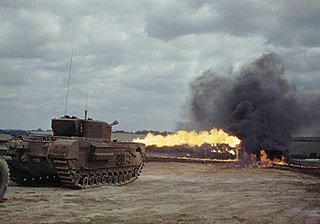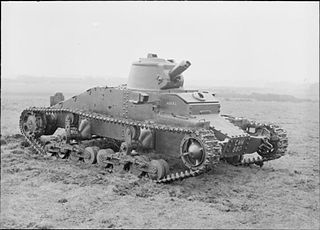 W
WThe infantry tank was a concept developed by the United Kingdom and France in the years leading up to World War II. Infantry tanks were designed to support infantrymen in an attack. To achieve this, the vehicles were generally heavily armoured to allow them to operate in close concert with infantry even under heavy fire. The extra armour came at the expense of speed, which was not an issue when supporting relatively slow-moving foot soldiers.
 W
WA20 was a British tank design by Harland and Wolff to meet an Army requirement for an infantry tank that could replace the Matilda II and Valentine tank. It was designed in the expectation that conditions would be similar to those of the First World War.
 W
WThe Tank, Infantry, Mk IV (A22) Churchill was a British heavy infantry tank used in the Second World War, best known for its heavy armour, large longitudinal chassis with all-around tracks with multiple bogies, its ability to climb steep slopes, and its use as the basis of many specialist vehicles. It was one of the heaviest Allied tanks of the war.
 W
WTank, Infantry, Black Prince (A43) is the name that was assigned to an experimental development of the Churchill tank with a larger, wider hull and a QF 17-pounder (76 mm) gun. It was named after Edward, the Black Prince, a famous 14th century military leader.
 W
WThe Churchill Crocodile was a British flame-throwing tank of late Second World War. It was a variant of the Tank, Infantry, Mk IV (A22) Churchill Mark VII, although the Churchill Mark IV was initially chosen to be the base vehicle.
 W
WThe Tank, Infantry, Mk IV (A22) Churchill was a British heavy infantry tank used in the Second World War, best known for its heavy armour, large longitudinal chassis with all-around tracks with multiple bogies, its ability to climb steep slopes, and its use as the basis of many specialist vehicles. It was one of the heaviest Allied tanks of the war.
 W
WThe Tank, Infantry, Mk IV (A22) Churchill was a British heavy infantry tank used in the Second World War, best known for its heavy armour, large longitudinal chassis with all-around tracks with multiple bogies, its ability to climb steep slopes, and its use as the basis of many specialist vehicles. It was one of the heaviest Allied tanks of the war.
 W
WThe Tank, Infantry, Mk IV (A22) Churchill was a British heavy infantry tank used in the Second World War, best known for its heavy armour, large longitudinal chassis with all-around tracks with multiple bogies, its ability to climb steep slopes, and its use as the basis of many specialist vehicles. It was one of the heaviest Allied tanks of the war.
 W
WThe Tank, Infantry, Mk IV (A22) Churchill was a British heavy infantry tank used in the Second World War, best known for its heavy armour, large longitudinal chassis with all-around tracks with multiple bogies, its ability to climb steep slopes, and its use as the basis of many specialist vehicles. It was one of the heaviest Allied tanks of the war.
 W
WThe Tank, Infantry, Mk IV (A22) Churchill was a British heavy infantry tank used in the Second World War, best known for its heavy armour, large longitudinal chassis with all-around tracks with multiple bogies, its ability to climb steep slopes, and its use as the basis of many specialist vehicles. It was one of the heaviest Allied tanks of the war.
 W
WThe Tank, Heavy Assault, A33 (Excelsior) was a British experimental heavy tank based on the Cromwell (A27) design developed in the Second World War. It was developed when there were concerns as to performance of the Churchill tank.
 W
WThe Tank, Infantry, Valiant (A38) was a British tank design of the Second World War that only reached the prototype stage. Intended to meet the specification for a lightweight but heavily armoured tank for use in the war in the Far East, it proved to be a failure. The sole example was retained by the School of Tank Technology after the war as a lesson to its students.
 W
WThe Infantry Tank Mark II, best known as the Matilda, was a British infantry tank of the Second World War.
 W
WThe Tank, Infantry, Mk I, Matilda I (A11) was a British infantry tank of the Second World War. Despite being slow, cramped and armed with only a single machine gun, the Matilda I had some success in the Battle of France in 1940, owing to its heavy armour which was proof against the standard German anti-tank guns. However, it was essentially useless in an attacking sense, as its weak armament made it toothless in combat against enemy armour, and the tank was obsolete before it even came into service. The Battle of France was the only time the Matilda I saw combat. The tank was cheaply built as the British government wanted each of the tanks to be built on a very restricted budget in the build up to the Second World War. It is not to be confused with the later model Tank, Infantry Mk II (A12), also known as the "Matilda II", which took over the "Matilda" name after the Matilda I was withdrawn from combat service in 1940. They were completely separate designs.
 W
WThe Infantry Tank Mark II, best known as the Matilda, was a British infantry tank of the Second World War.
 W
WThe Tank, Infantry, Mk III, Valentine was an infantry tank produced in the United Kingdom during World War II. More than 8,000 of the type were produced in eleven marks, plus various specialised variants, accounting for approximately a quarter of wartime British tank production. The many variants included riveted and welded construction, petrol and diesel engines and a progressive increase in armament. It was supplied in large numbers to the USSR and built under licence in Canada. It was used extensively by the British in the North African campaign. Developed by Vickers, it proved to be both strong and reliable, which was unusual for British tanks of the period.
 W
WThe Tank, Infantry, Valiant (A38) was a British tank design of the Second World War that only reached the prototype stage. Intended to meet the specification for a lightweight but heavily armoured tank for use in the war in the Far East, it proved to be a failure. The sole example was retained by the School of Tank Technology after the war as a lesson to its students.